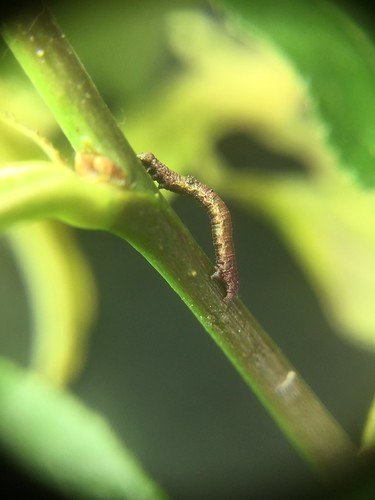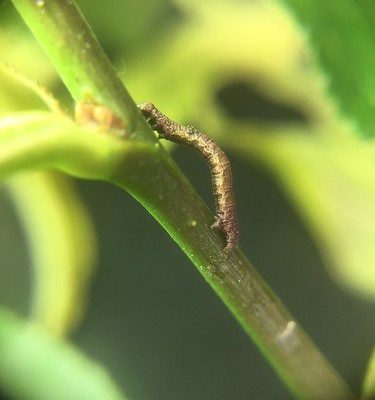
Inchworms, which belong to the caterpillar stage of certain moths, are famous for their unique inching movement. They look like tiny green or brown segments with a knack for blending into their surroundings. If you’ve got young fruit trees, understanding how inchworms operate can be crucial to keeping your trees healthy and productive. Let’s dive into what you need to know about these little creatures and how they can impact your saplings.
What Are Inchworms, Anyway?
Inchworms might look harmless, but don’t let their small size fool you. Typically, they’re the larvae of moths from the Geometridae family. When you spot one inching along a branch or a leaf, you might not realize they’re on a mission. They have a voracious appetite, particularly for tender leaves, which are like candy to them.
These worms can vary in color and size, but most commonly, they’re a soft green or brown, camouflaging perfectly against the foliage. Here’s a fun tidbit: when threatened, inchworms often drop to the ground and curl up, making them look like twigs or bits of debris. This behavior is a defense mechanism—who wouldn’t want to avoid being someone’s lunch?
In terms of lifecycle, inchworms usually hatch in the spring when trees are starting to bud. That means if you have young fruit trees, you could face an invasion at the same time that your plants are growing their freshest leaves. If left unchecked, inchworms can cause serious damage.
How Do Inchworms Affect Young Fruit Trees?
Here’s the thing: inchworms love young leaves and tender shoots. When these small larvae feed, they can quickly strip a tree of its foliage, which is like taking away a child’s toys. Without leaves, young fruit trees can’t photosynthesize effectively, stunting their growth and affecting their overall health.
Young trees are still building their root systems and relying heavily on their leaves for energy. If you notice your saplings losing their leaves, it might be inchworms at work. Often, they’ll eat the leaves down to the midrib, leaving behind a skeletal structure that looks unhealthy and sad.
In severe cases, this feeding can lead to greater issues, like stunted growth or even tree death. So, if you spot inchworms, it’s essential to act quickly.
Signs of an Inchworm Infestation
If you suspect that inchworms are munching on your trees, it’s time to play detective. Keep an eye out for several signs that indicate an infestation:
- Missing Leaves: This is usually the most obvious sign. If your tree’s leaves seem to be disappearing, inchworms may be the culprits.
- Skeletonized Leaves: Look for leaves that look like lace. Inchworms tend to eat just the surface of the leaf, leaving behind a web of veins.
- Presence of Inchworms: You might literally see them hanging around the branches, munching away. Check the underside of leaves, as they like to hide there.
- Frass: This is a fancy term for insect droppings. You may notice small pellets on or beneath the tree, another telltale sign of an inchworm party.
If you see these signs, it’s crucial to act. Ignoring the issue could lead to significantly more damage.
How to Control Inchworms
Controlling inchworms effectively requires a mix of vigilance and action. Here are proven strategies to address an infestation:
1. Handpicking: For smaller infestations, simply picking the inchworms off your trees can be quite effective. Wear gloves and gently remove them, then drop them into a bucket of soapy water.
2. Insecticidal Soap: If handpicking feels like an uphill battle, consider using insecticidal soap. This option is safer for young trees and the environment. Follow the instructions carefully, spraying mainly on the foliage.
3. Natural Predators: Encourage birds and beneficial insects like ladybugs, which feast on inchworms. Planting flowers nearby can attract these helpful creatures.
4. Monitoring: Keep an eye on your trees regularly. Catching inchworms early means you can prevent severe damage, so don’t skip this step!
When to Seek Professional Help
Sometimes, despite our best efforts, an infestation can get out of hand. If you’ve noticed a significant decline in your tree’s health or the infestation is too large to handle, it might be time to call in the pros.
Professional arborists or pest control specialists have the tools and expertise to tackle larger infestations safely and effectively. They can evaluate the tree’s overall health and provide targeted treatments that can save your young fruit trees from harm.
Why It Matters: The Bigger Picture
You might be wondering—why should I care about inchworms if they’re just a small part of the ecosystem? Here’s the thing: every piece of the puzzle matters. Young fruit trees play an essential role in our environment, providing food not just for us but also for wildlife. Protecting them ensures a healthy ecosystem.
Furthermore, healthy fruit trees contribute to biodiversity and can even affect local climates. So, by managing inchworms, you’re not just safeguarding your trees but also supporting a balanced environment.
Inchworms can be sneaky little pests, but understanding their impact on young fruit trees allows you to take proactive steps. With regular monitoring and appropriate action, you can keep your saplings thriving. Remember, caring for your trees is like nurturing a child—every little effort counts.
So, keep an eye out for those inchworms, and take pride in creating a healthy environment for your young fruit trees. After all, a fruitful garden is a happy garden!

